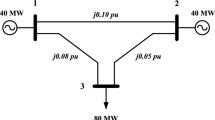Abstract
A predictor–corrector interior-point method is developed in order to deal with the AC active and reactive optimal power flow problem. Voltage rectangular coordinates are adopted instead of polar ones, since they allow nonlinear corrections for the primal and dual feasibility conditions and not only for the complementary constraints as in the traditional nonlinear programming methods. A new heuristic is proposed to handle voltage magnitude constraints. Computational experiments for IEEE test systems and a real Brazilian system are presented and show the advantages of the proposed approach.
Similar content being viewed by others
References
Castillo A, O’Neill RP (2013) Computational performance of solution techniques applied to the ACOPF. Federal Energy Regulatory Commission, Optimal Power Flow Paper 5
Cain MB, O’Neill RP, Castillo A (2012) History of optimal power flow and formulations. Federal Energy Regulatory Commission, Optimal Power Flow Paper 1
Carpentier J (1962) Contribution a l’etude du dispatching economique. Bulletin de la Societe Francaise des Electriciens 3:431–447
El-Bakry AS, Tapia RA, Tsuchiya T, Zhang Y (1996) On the formulation and the theory of the Newton interior-point method for nonlinear programming. J Optim Theory Appl 89:507–541
Garzillo A, Innorta M, Ricci R (1999) The flexibility of interior point based power flow algorithms facing critical network situations. Electr Power Energy Syst 21:579–584
Huneault M, Galiana FD (1991) A survey of the optimal power flow literature. IEEE Trans Power Syst 6(2):762–770
Jiang Q, Geng G, Guo C, Cao Y (2010) An efficient implementation of automatic differentiation in interior point optimal power flow. IEEE Trans Power Syst 25(1):147–155
Jiang QY, Chiang HD, Guo CX, Cao YJ (2009) Power-current hybrid rectangular formulation for interior-point optimal power flow. IET Gener Trans Distrib 3(8):748–756
Karmarkar N (1984) A new polynomial-time algorithm for linear programming. Combinatorica 4(4):373–395
Lavaei J, Low SH (2012) Zero duality gap in optimal power flow problem. IEEE Trans Power Syst 27(1):92–107
Lin WM, Huang CH, Zhan TS (2008) A hybrid current-power optimal power flow technique. IEEE Trans Power Syst 23(1):177–185
Mehrotra S (1992) On the implementation of a primal-dual interior point method. SIAM J Optim 2(4):575–601
Momoh JA, El-Hawary ME, Adapa R (1999) A review of selected optimal power flow literature to 1993, part I: Nonlinear and quadratic programming approaches. IEEE Trans Power Syst 14(1):96–104
Momoh JA, El-Hawary ME, Adapa R (1999) A review of selected optimal power flow literature to 1993, part II: Newton, linear programming and interior point methods. IEEE Trans Power Syst 14(1):105–111
Momoh JA (2001) Electric power system applications of optimization. Marcel Dekker, New York
Monticelli AJ (1983) Fluxo de Carga Em Redes de Energia Elétrica. Edgar Blucher, São Paulo
Pandya KS, Joshi SK (2008) A survey of optimal power flow methods. J Theor Applied Inf Technol 4(5):450–458
Quintana VH, Torres GL, Medina-Palomo J (2000) Interior point methods and their applications to power systems: a classification of publications and software codes. IEEE Trans Power Syst 15(1):170–176
Torres GL, Quintana VH (1998) An interior-point method for nonlinear optimal power flow using voltage rectangular coordinates. IEEE Trans Power Syst 13:1211–1218
Torres GL, Quintana VH (2000) Optimal power flow by a nonlinear complementarity method. IEEE Trans Power Syst 15(3):1028–1033
Wang H, Murillo-Sanchez CE, Zimmerman RD, Thomas RJ (2007) On computational issues of market-based optimal power flow. IEEE Trans Power Syst 22(3):1185–1193
Wright SJ (1996) Primal-dual interior-point methods. SIAM Publications, Philadelphia
Author information
Authors and Affiliations
Corresponding author
Additional information
This research was partially sponsored by the Foundation for the Support of Research of the State of São Paulo (FAPESP) and the Brazilian Council for the Development of Science and Technology (CNPq).
Rights and permissions
About this article
Cite this article
Probst, R.W., Oliveira, A.R.L. A new predictor–corrector method for optimal power flow. Optim Eng 16, 335–346 (2015). https://doi.org/10.1007/s11081-014-9265-7
Received:
Accepted:
Published:
Issue Date:
DOI: https://doi.org/10.1007/s11081-014-9265-7




